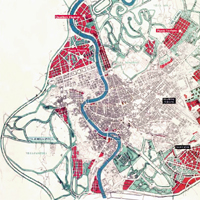Urban Transformations in the After-Unity Capitals: Turin, Florence, Rome
Abstract
The Italian political unification is a process starting in 1861. The next ten years, until the freeing of Rome, are a period of strong changes because the the new nation starts by heavier backwardness conditions compared to other European nations.
The basic conditionings that bound the new nation are summarized in some causes: an underdeveloped economic system where there are areas of industrial development; a significant shortage of mineral and energy resources; and an urban structure that is still that of the sixteenth century, the last brightness period of the Italian cities. The same internal communication system is composed of a basic road network which is still one of Roman origin and of isolated sections of rail network, with few links among the pre-unity nations.
Particular attention should be paid on the impact of the economic processes on the cities: they have a strong impact on European cities since the early nineteenth century, but their impact on Italian cities (beginning from the main northern cities, Milan and Turin) is more limited, if compared with the transformations concerning other continental cities.
The unification starting from 1861 imposes additional critical elements, because the Italian urban structure is not ready to the event, particularly for the choice of the capital city. A city that can rightfully define itself as capital exists, and it is Turin; but it is peripheral to the rest of the Italian territory. Furthermore there is an in pectore capital city, Rome, that is the symbolic centre of the Italian history. But the city has to wait another ten years to join to the rest of Italy. The solution is to temporarily move the capitol to Florence, even if nobody explicitly says it to Florentines! The step from Turin to Florence, and from Florence to Rome sets in motion a complex organizational mechanism and a significant money‘s amount, invested in the effort to bring the two cities to the new role.
Before Florence, then Rome (two cities that represent a fundamental part of artistic and cultural national heritage) see the opportunity to modernize their urban structure. Urban plans are also formed for this purpose, although the instruments are deficient in relation to their technical capacity and the public administrations have low authority in the driving of the transformations. Instead, private investors and national and international banks will have open hand, facilitated from the new liberal State that will not hinder the freedom of action of private capitals.
The paper want to identify the major changes occurred in the three capital cities (Turin, Florence, and Rome) investigating the urban processes and the main events in the period from 1861 to 1900. The unification acts on the three cities in different ways. In 1861 they are very different from each other, with a single similar factor, the number of inhabitants (about 150,000 each). The process of building of the new nation acts on the cities changing even more their characters and extending their differences.
Downloads
References
AAVV (2004) Roma, Touring Club Italiano, Roma Caracciolo A. (1999) Roma capitale: dal Risorgimento alla crisi dello stato liberale, Editori Riuniti, Roma.
Comoli Mandracci V. (1983) Le città nella storia d’Italia – Torino, Editori Laterza, Bari Roma.
Comoli Mandracci V. (2005) “Da città-capitale dell’assolutismo a capital dell’industria”, in AAVV, Torino e Valle D’Aosta, Touring Club Italiano, Roma.
Detti E. (1970) Firenze scamparsa, Vallecchi, Firenze.
Fanelli G. (1985) Le città nella storia d’Italia – Firenze, Editori Laterza, Bari Roma.
Fanelli G. (2005) “La città dei Piani”, in AAVV, Firenze e Provincia, Touring Club Italiano, Roma.
Fei S. (1971) Nascita e sviluppo di Firenze città borghese, G & G Editrice, Firenze.
Fiori S. (2011) “Roma, Italia. Pavone ‘così è nato l’amore-odio per la capitale’”, la Repubblica, 25 febbraio.
Fried Robert C. (1973) Planning the eternal city. Roman Politics and Planning since World War II, Yale University Press, New Haven.
Ippolito F. (1988) Amici e maestri: personaggi, fatti e maestri, Dedalo, Bari.
Pavone C. (2011) Gli inizi di Roma Capitale, Bollati Boringhieri, Torino.
Piacentini M. (1952) Le vicende edilizie di Roma dal 1870 ad oggi, Fratelli Palombi Editore, Roma.
Ragon M. (1971) Histoire mondiale de l’architecture et de l’urbanisme modernes, Casterman, Bruxelles.
Spini G. (1971) “Introduzione”, in S. Fei, Nascita e sviluppo di Firenze città borghese, G & G Editrice, Firenze.

Copyright (c) 2014 Tema. Journal of Land Use, Mobility and Environment

This work is licensed under a Creative Commons Attribution 4.0 International License.
Authors who publish in this journal agree to the following:
1. Authors retain the rights to their work and give in to the journal the right of first publication of the work simultaneously licensed under a Creative Commons License - Attribution that allows others to share the work indicating the authorship and the initial publication in this journal.
2. Authors can adhere to other agreements of non-exclusive license for the distribution of the published version of the work (ex. To deposit it in an institutional repository or to publish it in a monography), provided to indicate that the document was first published in this journal.
3. Authors can distribute their work online (ex. In institutional repositories or in their website) prior to and during the submission process, as it can lead to productive exchanges and it can increase the quotations of the published work (See The Effect of Open Access)
